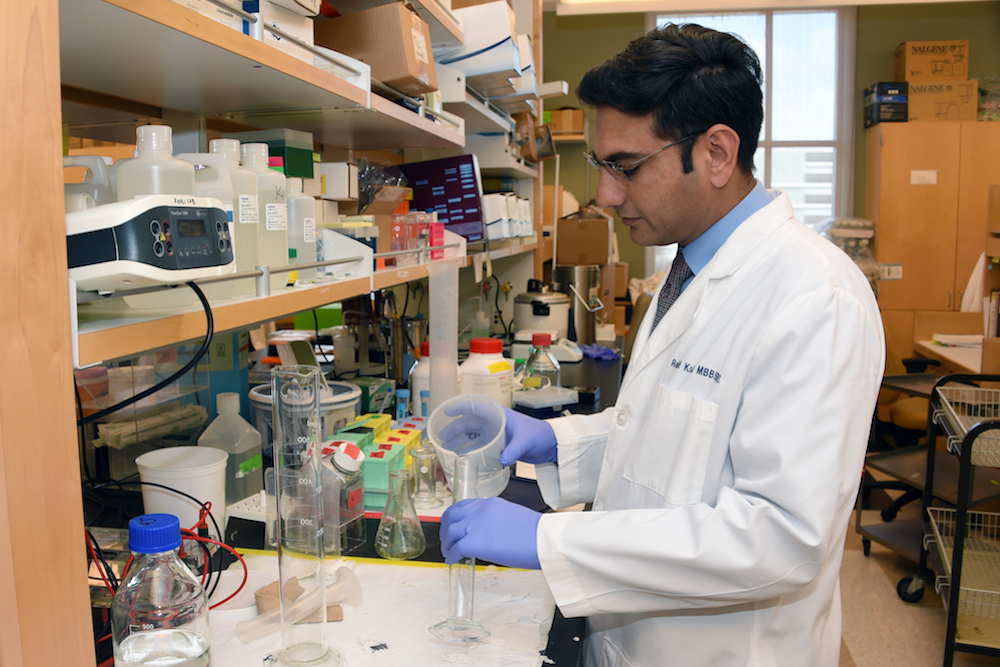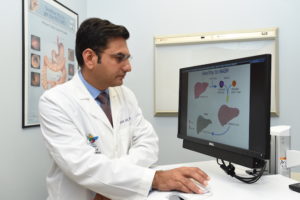
With other scientists, I study pediatric obesity and liver disease in the laboratory. Photo courtesy of Juan Ocampo.
How can we wean children off sugar?
Answering that question is the focus of my research and practice at Children’s Hospital Los Angeles, where I’m chief of gastroenterology, hepatology, and nutrition. Here in Southern California, we face a silent tsunami of obesity, diabetes, liver disease, and more, afflicting the health of our community.
The prevalence of sugar-driven diseases has had an especially devastating impact on children of Latin American heritage who have immigrated to the U.S. during the last few decades when fast food options that are relatively inexpensive but calorie-dense have been more readily available. Gravitating towards this type of diet sets children up for devastating long-term health consequences. Research has found that children of Hispanic backgrounds have a greater genetic predisposition to damage from sugar-rich diets that can lead to obesity and, in the long run, increased rates of cancer—and even liver failure—necessitating liver transplantation in young adulthood.
As a researcher, my efforts to combat this epidemic have been shaped by the susceptibility of immigrant families, but also by my own diverse experiences growing up around the world and then immigrating to the United States.
In retrospect, I was fortunate to have an untethered upbringing. My family is from India, where I was born and spent my early years. But after that, we moved to follow my dad’s career, spending time in both the Middle East and Asia. These varied experiences helped make me who I am today: open to new ideas and to understanding how best I can help all people.
My basic medical education occurred in India, where we were challenged every day to achieve the best outcomes for our patients, even with resources that were sometimes limited.
After my medical training in India, I worked as a junior researcher studying pediatric liver disease before immigrating to the United States to get advanced training. I trained in pediatric liver disease management, including liver transplantation for children, at Northwestern University, then worked at Cincinnati Children’s Hospital. At the end of my tenure there I served as head of the liver transplant program for children. Today, I continue my work at Children’s Hospital Los Angeles, leading one of the top pediatric teams in the nation specializing in digestive disorders and liver transplantation. My work here falls into three main areas.
About one-third of my time involves the administration of our Gastroenterology division. Our healthcare infrastructure in the United States is complex and therefore can at times be expensive. In this role, I frequently lean on my early days of medical training in India where being respectful of resources was paramount. Using lessons from my past, I attempt to provide the best outcomes for children under our care today.
Another third of my time is spent being a clinician, treating patients and talking with their families. Many of the families I have the privilege of treating are immigrant families with limited resources. So, when I talk with a family about their child’s obesity-related liver disease, I am very aware of these limitations to their care and treat the 15–20 minutes I have with them with the utmost regard.
This time is extremely important to them. Years ago, I often gave people the whole textbook on what they were facing, but that didn’t work out so well. My wife, who is a social worker, convinced me that a physician needs to be understood, and that means not being so “clinical” in one’s message that you lose empathy. I’ve therefore learned to focus the information I share with each family to what is actionable and practical—I can’t tell them to go to the park if the parks where they live are not considered safe, and it’s hard to ask them to eat more fresh vegetables if they are in an area without grocery stores.
Instead, I focus on getting people—both patients and their families—to avoid sugar. Sports drinks, fruit juices, soda pop and any sweetened drinks should be avoided. “If it’s sweet and you can pour, kick it out the door,” is one of my adages. This is advice I know they can remember and hopefully use in their daily lives!

Photo courtesy of Juan Ocampo.
The final third of my time is spent on research: with other scientists, I study pediatric obesity and liver disease in the laboratory. In the laboratory, we work on understanding the mechanisms behind the damage caused by sugar and sugar substitutes in the development of obesity and its frequent association with other conditions such as fatty liver disease and diabetes. I take on this challenge to research the mechanisms of fatty liver diseases, not only to change outcomes of patients at a clinical level, but also to better understand the cellular mechanisms that result in weight loss and hopefully help lead to new treatments for fatty liver disease.
It is this research that truly breaks down the walls between different parts of my work life. When you are a clinician, you reach one person at a time, but from research I can take principles that apply all over the world, including to the children and neighbors across all the places I spent growing up.
All these roles have taught me to believe very strongly in advocacy and community partnership for effecting real, lasting change. Case in point: when science influences legislation and public policy to discourage consumption of sugar-sweetened beverages, children’s health improves. Another example: Children’s Hospital Los Angeles partners with federally qualified health centers to successfully serve diverse populations and apply science that shows us how to treat obesity and its related health problems.
And that, perhaps, is a perfect example of how all these nuances are linked–culture informing care, research influencing results, all in the embrace of public policy that recognizes not only problems but proven solutions–and in healthcare, nuances make all the difference. That’s something I understand as a doctor, a researcher, an administrator—and as an immigrant.




Send A Letter To the Editors